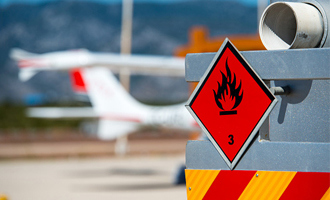

Some items may endanger the safety of an aircraft or persons on board, and these dangerous materials can either be forbidden or restricted for air transport. IATA leads industry efforts to ensure the safe transport of dangerous goods by air. We provide a great variety of technical knowledge, products, services and training solutions, tailored to satisfy industry needs.
The development of standards for documentation, handling and training, as well as the promotion and use, contributed to achieving a very high degree of safety in the transport of dangerous goods by air.
IATA works closely with local governments and ICAO in the development of regulations. This way, we ensure that the rules and guidelines on dangerous goods transport are effective and operational practical. The IATA Dangerous Goods Regulations (DGR) manual is the global reference for shipping dangerous goods by air and the only standard recognized by airlines.
2024 UPDATES: IATA manuals include all necessary information about new regulations taking effect as of January 1, 2024 and how they impact the shipment and handling of air cargo. Learn more about 2024 updates
Addendum to the 65th Edition: Addendum in English (pdf)
The former Appendix H in the Dangerous Goods Regulations is now a stand-alone “Dangerous Goods Training Guidance” (Edition 1). This guidance document is the practical guide for the industry players to develop their training framework in accordance with the current provisions on competency-based training and assessment (CBTA).
The IATA DG Community is the meeting place where shippers, freight forwarders, and airlines have a say. Join us to find out what information you need to know, give us feedback and share with your peers.
The DGB reviews and determines standards and procedures necessary for the safe carriage of dangerous goods by air, and promotes the worldwide recognition, adoption of and adherence to those standards and procedures.
The DGB meets twice a year, normally in March and September prior to the ICAO Working Group or Panel Meetings.
The DGB consists of 12 Board members, elected by the Cargo Services Conference (CSC), each being an expert in the dangerous goods field and serving on the Board for a period of four years. IATA member airlines and other associations, such as IFALPA and aircraft manufacturers may send observers to the DGB meetings, subject to prior approval of the Secretary and Chairman.
The current DGB Chairman is Mr. Trevor Howard (EK).
The Dangerous Goods Regulations (DGR) is available in English, Chinese, French, German, Russian and Spanish. A Japanese edition is produced under license by JACIS.
Secretary
Ben Firkins
Head, Cargo Safety & Dangerous Goods, IATA
The Dangerous Goods Training Working Group (DGTWG) reports to the Dangerous Goods Board, establishes, reviews and updates dangerous goods training standards using a competency-based training and assessment approach (CBTA).
The primary objectives of the DGTWG include:
The DGTWG meets twice a year, usually in May and October after the IATA DGB Meetings.
The DGTWG consists of 12 members nominated by the Cargo Services Conference (CSC) and other groups representing the members, such as IATA Ground Handling Council (IGHC), Airport Services Association (ASA) and other Industry Trade Associations, and appointed by the Dangerous Goods Board (DGB), each being an expert in the dangerous goods training area. IATA member airlines and other associations, such as FIATA may send observers to the DGTWG meetings, subject to the prior approval of the Secretary and Chairman.
The current DGTWG Chairman is Jesper Lange (Cargolux).